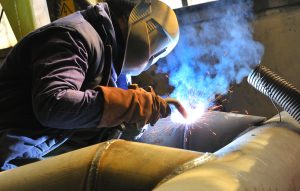Hazardous substances in welding fumes: How they affect the human body
Welding fumes affect the lungs and are toxic or carcinogenic. The health consequences for the welder depend mainly on the composition of welding fumes. Science differentiates between three effects.
The hazardous substances in welding fumes created during welding are formed of several components: Basic and supplementary materials, inert gases, coatings, contamination and ambient air. Prerequisite for the formation of hazardous substances are certain physical and/or chemical processes. This includes: Evaporation, condensation, oxidation, decomposition, pyrolysis and combustion. The type and quantity of the hazardous substances in welding fumes depend on the welding process and the materials used. Their effect can be divided into three categories:
- Respiratory and lung damaging substances
- Toxic (poisonous) hazardous substances
- Carcinogen (carcinogenic) hazardous substances
Hazardous substances in welding fumes damage lungs and respiratory system
 If welders are exposed to a high concentration of these hazardous substances in welding fumes over a longer period, then this may lead to a strain on the respiratory system, specifically the lungs. Respiratory diseases such as bronchitis up to a permanent narrowing of the respiratory system (obstructive bronchitis) are the consequence.
If welders are exposed to a high concentration of these hazardous substances in welding fumes over a longer period, then this may lead to a strain on the respiratory system, specifically the lungs. Respiratory diseases such as bronchitis up to a permanent narrowing of the respiratory system (obstructive bronchitis) are the consequence.
Furthermore, dust deposits can settle in the lungs. These may occur in the form siderosis (iron overload) when working with iron oxides. The absorption of high concentrations of hazardous substances in welding fumes also triggers fibrogenic reactions (connective tissue proliferation) in the lungs. Substances affecting the lungs and their effect on the human body are e.g.:
- Iron oxides: Dust deposits in the lung (welders’ lung or lung siderosis) / Siderosis (leads to joint problems, diabetes, congestive heart failure or impotence)
- Aluminum oxide: Aluminosis (aluminum dust lung, causes a change of the functional lung tissue into non-functional tissue)
- Magnesium oxide: Fever, sweats, tickle in the throat / Irritation of the eyes and nasal mucosa / Impaired lung function
- Titanium dioxide: Dust deposits in the lungs / Damage of liver, spleen, kidneys, heart and brain / Weakening of the immune system
Poisonous hazardous substances in welding fumes can be fatal
Toxic (poisonous) hazardous substances in welding fumes have a toxic effect in the body once a certain concentration is reached. The concentration is decisive with regards to the effect: Whilst slight poisoning may lead to minor health problems, large concentrations of these hazardous substances in welding fumes may cause life-threatening poisoning or at worst be fatal. Depending on hazardous substances, the dangerous dose varies according to the hazardous substances. The toxic hazardous substances in welding fumes include:
 Manganese oxide: Irritant effect on the respiratory system /Pneumonia / Damages of the nervous system / Parkinson’s disease
Manganese oxide: Irritant effect on the respiratory system /Pneumonia / Damages of the nervous system / Parkinson’s disease- Zinc oxide: Zinc fever (nano-particles in the lungs lead to cell necrosis)
- Copper oxide: Nausea, diarrhea, pain in the eyes / Metal fume fever (malaise with symptoms similar to having the chills) / Damage of liver and kidneys
- Nitrogen oxides: Irritation of the respiratory system and shortness of breath / Potentially fatal pulmonary oedema (lung dropsy)
- Carbon monoxide: Prevents the oxygenation of blood and thus leads to an undersupply of organs / Dizziness, fatigue, headaches, fainting, pulse and breathing increase in pulse rate and quicker breathing / Unconsciousness, respiratory paralysis, cardiac arrest
- Carbon dioxide: Increased respiratory rate and volume / Dizziness, headache, shortness of breath and unconsciousness
- Phosgene: Severe respiratory system irritation / Pulmonary oedema
Further toxic hazardous substances in welding fumes are soluble barium compounds, calcium oxide, fluorides and vanadium pentoxide.
Particularly dangerous: carcinogenic hazardous substances in welding fumes
Carcinogenic hazardous substances in welding fumes can cause malignant tumors in the body. Furthermore, these substances also have a toxic effect in many cases. In general, the cancer risk depends on several factors such as genetic predisposition or environmental impact. Thus, there are no documented figures on the exact impact of hazardous substances. There is, however, proof that an increasing dose of these hazardous substances in welding fumes increases the risk of cancer. Scientists from the World Health Organization (WHO) have found an increased risk of lung cancer for welders.
For carcinogenic substances, no threshold value is known below which there is no longer any risk. Therefore, especially here, there is a need for minimization as per the Hazardous Substances Regulation. Examples for hazardous substances in welding fumes are:
- Chrome(VI)-compounds: Irritation and chemical burns to the mucosa
- Lead oxide: Nerve and kidney damage / Gastrointestinal disorders / Nausea
- Nickel oxide: Carcinogen in the respiratory organs
- Beryllium oxide: Metal fume fever / Chronic pneumonia
- Cadmium oxide: Mucous membrane irritation / Hyperinflation
- Cobalt oxide: Respiratory organ damage
- Ozone: Mucous membrane irritation / Acute acute irritant gas poisoning / Delayed pulmonary edema
- Formaldehyde: Severe mucosa irritation





